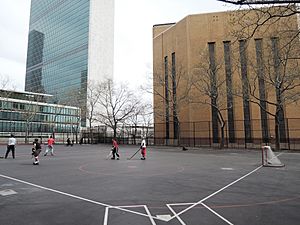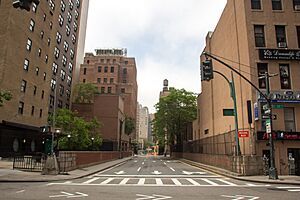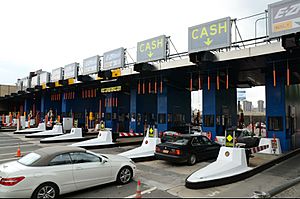Queens–Midtown Tunnel facts for kids
 |
|
| Overview | |
|---|---|
| Location | Manhattan and Queens, New York City, New York, US |
| Coordinates | 40°44′44″N 73°57′53″W / 40.74556°N 73.96472°W |
| Route | |
| Operation | |
| Operator | MTA Bridges and Tunnels |
| Traffic | 73,470 (2016) |
| Toll | As of August 6, 2023, $11.19 (Tolls By Mail and non-New York E-ZPass); $6.94 (New York E-ZPass); $9.11 (Mid-Tier NYCSC E-Z Pass) |
| Technical | |
| Length | 6,414 feet (1,955 m) (northern tube) 6,272 feet (1,912 m) (southern tube) |
| Number of lanes | 4 |
| Tunnel clearance | 12 feet 1 inch (3.68 m) |
| Route map | |
The Queens–Midtown Tunnel is a major road tunnel in New York City. It goes under the East River, connecting the areas of Manhattan and Queens. This tunnel is made of two separate tubes, and each tube has two lanes for cars. The tunnel is part of Interstate 495 (I-495).
The idea for the Queens–Midtown Tunnel first came up in 1921. Over the years, the plans changed a few times. Construction finally began in 1936. The tunnel was designed by Ole Singstad and opened to traffic on November 15, 1940. Today, the tunnel is owned by New York City. It is managed by MTA Bridges and Tunnels, which is part of the Metropolitan Transportation Authority. Many express buses use the tunnel every day.
Contents
Exploring the Tunnel's Design and Route
The Queens–Midtown Tunnel has two tubes. Each tube carries two lanes of traffic. The southern tube usually carries traffic heading east to Queens. The northern tube usually carries traffic heading west to Manhattan. During busy morning hours, one lane in the southern tube can change direction. It becomes a special lane for cars with many people or buses going west.
The northern tube is a bit longer, measuring about 6,414 feet (1,955 meters). The southern tube is about 6,272 feet (1,912 meters) long. In Queens, the tunnel entrances are next to each other. But in Manhattan, they are slightly separated.
How Cars Enter and Exit the Tunnel
The tunnel's eastern end is in Long Island City, Queens. Here, Interstate 495 goes down into the tunnel. There used to be a place to pay tolls here. Now, tolls are collected differently. There are also exits and entrances for I-495 nearby.
The tunnel tubes go under the East River. They then curve south under First Avenue in Manhattan. Finally, they turn west between 36th and 37th Streets.
On the Manhattan side, both tubes come up to street level near Second Avenue. The westbound road splits into three exit ramps. These ramps lead to 37th Street or a special road called Tunnel Exit Street. This street connects to 34th Street and 41st Street. The southern tube rises to ground level. It connects with eastbound traffic from 36th Street and other entrance ramps. These ramps are called Tunnel Entrance Street. Tolls are now collected electronically near the Manhattan entrances.
Tunnel Features and Safety
The two tubes were built with a diameter of about 31 feet (9.4 meters). The road inside is about 21 feet (6.4 meters) wide. The maximum height for vehicles is 12 feet 1 inch (3.68 meters). Each tunnel entrance has large flood doors. These doors weigh about 20 short tons (18 metric tons). They are 2 feet (0.61 meters) thick and 29 feet (8.8 meters) tall. These doors can close to protect the tunnel from floods.
The tunnel has two special buildings called ventilation buildings. One is in Manhattan, and one is in Queens. Both are tall, orange brick buildings designed in the Art Deco style. They are about 100 feet (30 meters) tall. These buildings have powerful fans. These fans can completely clean the air inside the tunnel in just 90 seconds.
The Manhattan ventilation building is next to the Robert Moses Playground. This playground is run by the New York City Department of Parks and Recreation. The Queens ventilation building is in the middle of Borden Avenue. Cars drive around it.
Building the Queens–Midtown Tunnel
The idea for the Queens–Midtown Tunnel started in 1921. People wanted a new way to get from Midtown Manhattan to Queens and Brooklyn. At the time, bridges over the East River were very crowded. Many groups supported building the tunnel to help with traffic.
In 1927, the city decided to spend money to study the best places for the tunnel. By 1929, many groups wanted the tunnel built quickly. There was also a plan to connect the Queens–Midtown Tunnel to another tunnel. This other tunnel, the Lincoln Tunnel, would go under the Hudson River to New Jersey.
Getting Approval for Construction
In 1929, the city started studying the tunnel and the Triborough Bridge. They suggested building new highways to connect to the tunnel. The city also agreed to use tolls to pay for the tunnel's upkeep.
There were some legal challenges at first. But in 1929, the city set aside money for studies and early construction. Engineers also looked at how the tunnel would connect to the Midtown Hudson Tunnel. They also changed the plans for the tunnel's entrances in Manhattan.
In 1930, the United States Department of War approved the tunnel. This meant the tunnel would not get in the way of ships during wartime. However, construction was delayed because of concerns about the highway section in Manhattan.
Starting Construction in the 1930s
In 1935, Governor Herbert H. Lehman allowed the creation of a special group to build the tunnel. Mayor Fiorello H. La Guardia wanted the tunnel built soon. He thought it would help people get to the 1939 New York World's Fair in Queens. The tunnel builders asked the government for money.
In 1936, the federal government gave $58.3 million for the tunnel. This money would be paid back using tolls. The Queens–Midtown Tunnel became the biggest public works project in the United States not run by a federal agency.
Some people, like Robert Moses, thought a bridge would be better. They said it would be cheaper. But the tunnel had already received funding. So, the plan for a bridge was rejected.
Construction officially began on October 1, 1936, in Queens. President Franklin D. Roosevelt was there for the groundbreaking ceremony. Workers started digging test holes to check the ground. They found many rocks and some soft dirt under the river. They also had to be careful not to damage other nearby tunnels.
A special layer of clay was put at the bottom of the East River. This "blanket" of clay helped keep air pressure inside the tunnels. This was the first time this method was used for an underwater tunnel.
The project hired up to 2,500 "sandhogs" at a time. These workers dug the tunnels. Because of the high air pressure, they worked in short shifts. This helped prevent a condition called decompression sickness.
Work on the underwater part of the tubes began in April 1938. Workers used special machines called tunneling shields. They also used dynamite to blast through hard rock. Steel rings were then put inside the tunnel to support it.
In November 1939, the two parts of each tube met under the river. This was a big moment, and they were off by less than half an inch! By January 1940, all the metal rings were in place. The tunnel was almost finished.
Opening and Early Years
The Queens–Midtown Tunnel opened on November 15, 1940. President Franklin D. Roosevelt was the first person to drive through it. The tunnel was advertised as a way to save time, money, and gas. People in Queens hoped it would help their area grow.
The tunnel had new lighting technology. This helped drivers adjust their eyes when leaving the tunnel into sunlight. The first person to pay the toll was Henry Sokovit from Queens.
At first, fewer cars used the tunnel than expected. This was partly because other bridges were free. Also, during World War II, people used less gasoline. The tunnel even closed at night for a while. But by 1944, it was open 24 hours again. By 1949, the tunnel started making a profit.
In 1955, an experiment began. One lane of the eastbound tube was used for westbound traffic during morning rush hours. This helped with traffic flow.
Later Years and Changes
In 1971, a special lane was added to the eastbound tube. It was for buses and cars with many people during morning rush hour. This lane helped speed up travel for these vehicles.
From 1981 to 2016, the tunnel had a unique event each spring. It was called the "Ringling Bros. and Barnum & Bailey Circus Animal Walk." Circus elephants would walk through the tunnel into Manhattan. This happened a few nights before the circus opened. It was a tradition that many people came to watch. However, it also led to protests from groups concerned about animal welfare. When the circus stopped using elephants in 2016, the walk ended.
In 1995, the Queens–Midtown Tunnel got cell phone service. Also, the old brick road surface was replaced with asphalt. Later, the tunnel's roof was renovated.
After the September 11 attacks in 2001, there were temporary rules for cars entering Manhattan through the tunnel. These rules were removed in 2002.
In 2017–2018, the tiled walls inside the tunnel were replaced. They had been damaged by Hurricane Sandy in 2012. The new walls are white with gold and blue stripes, which are New York's state colors.
Bus Routes Using the Tunnel
The tunnel is used by many express bus routes. These buses help people travel quickly between Queens and Manhattan. Most of these routes use the tunnel when going west into Manhattan. Some routes use the Queensboro Bridge when going east into Queens.
Paying to Use the Tunnel
As of August 6, 2023, there is a toll to use the Queens–Midtown Tunnel. The price depends on how you pay. If you pay by mail or use an E-ZPass not from New York, it costs $11.19 for a car. If you have a New York E-ZPass, it costs $6.94 for a car.
Since January 10, 2017, the tunnel uses "open-road cashless tolling." This means there are no tollbooths where you stop to pay cash. Instead, cameras and E-ZPass readers are on overhead structures. If you have an E-ZPass, it reads your transponder. If you don't have an E-ZPass, a picture of your license plate is taken, and a bill is mailed to you.
How Tolls Have Changed Over Time
| Years | Toll |
|---|---|
| 1940–1972 | $0.25 |
| 1972–1975 | $0.50 |
| 1975–1980 | $0.75 |
| 1980–1982 | $1.00 |
| 1982–1984 | $1.25 |
| 1984–1986 | $1.50 |
| 1986–1987 | $1.75 |
| 1987–1989 | $2.00 |
| 1989–1993 | $2.50 |
| 1993–1996 | $3.00 |
| 1996–2003 | $3.50 |
| 2003–2005 | $4.00 |
| 2005–2008 | $4.50 |
| 2008–2010 | $5.00 |
| 2010–2015 | $6.50 |
| 2015–2017 | $8.00 |
| 2017–2019 | $8.50 |
| 2019–2021 | $9.50 |
| 2021–2023 | $10.17 |
| 2023–present | $11.19 |
See also
 In Spanish: Túnel Queens Midtown para niños
In Spanish: Túnel Queens Midtown para niños







